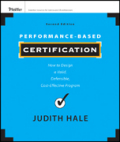
Performance-based certification: how to design a valid, defensible, cost-effective program
Hale, Judith
Are your employees qualified? Looking for qualified people to do competent work? How do you ensure that the people you hire can do the job right? An ever-increasing number of organizations are asking the same questions. Certificationplanning is the answer and Performance-Based Certification is the key. This is the only book on the market that addresses the growing need to monitor the qualifications of employees. You'll be able to quickly customize the certification tests and other job aids provided on the accompanying disk. Create a certification program within your organization to: Instill confidence that employees, members, or suppliers are qualified to meet the needs of your customers Ensure that your workforce is trained and competent to their job Make your hiringprocess more cost effective and legally defendable Recognize competence and consistency of your employees Once you've identified the need for a certification program, what's the next step? All of the answers are here! INDICE: List of Tables, Figures, and Exhibits Contents of the Website Introduction Chapter 1 The Driver Why Organizations Certify Protecting the Public Reinforcing Professional Stature and Promoting Universal Standards Preparing People for Jobs Requiring Competencies in Multiple Disciplines Projecting Jobs and Enhancing Professional Stature Improving Business Processes Establishing Professional Credibility and Influencing Academic Curricula Establishing Uniform Performance Standards Protecting the Brand Name Raising the Level of Core Competencies Success Measures Who to Involve The Players Target Audience Stakeholders Benefits of Certification Missteps and Oversights Tips Summary Where to Learn More Notes Chapter 2 The Business Case What Goes into a Business Case Hypotheses, Premises, and Best Guesses Metrics, or Key Success Indicators Economic Metrics Noneconomic Metrics The Requirements Missteps and Oversights Tips Summary Where to Learn More Notes Chapter 3 The Requirements Distinctions AmongEligibility, Qualification, and Certification Roles Certification Plays Gatekeeping or Screening Recognizing Demonstrated Performance Recognizing DifferentLevels of Accomplishment or Different Capabilities Typical Requirements for Certification Acceptance of a Code of Conduct Eligibility Education, Training, and Development Endorsements Experience External Credentials Tests Work Samples Work or Personnel Records Maintenance and Recertification Missteps and Oversights Tips Summary Where to Learn More Notes Chapter 4 The Standards Competencies, Standards, and Criteria Defining the Scope of the Effort The Job or Task Analysis Traditional Job/Task Analysis Methodologies Controlling Bias SamplingError Design Error Administrative Error Design of the Credential Certificate vs. Certification The Elements Missteps and Oversights Tips Summary ProceduresFocus Groups The NGT Outcome-Based Competency Session Delphi Study Where to Learn More Note Chapter 5 Assessment Definitions Rigor and Validity Sampling Error Under-Representation Extraneous Abilities Test Specifications Design Errors Administrative Error Types of Test Items Response-Supplied Items Response-Not-Supplied Items Computer-Based Testing Determining the Passing Score InformedJudgment Method Contrasting Group Method Conjectural (Angoff-Nedelsky) MethodIssues in Assessment and Testing Opportunity to Learn Adequate Time and Resources Face Validity Documentation Missteps and Oversights Tips Summary Where toLearn More Chapter 6 Governance and Administration Responsibilities of the Governance Board Candidates Rights Disclosure Appeals and Exemptions Preparationand Remediation Ethics Fees and Compensation Test Administration Responsibilities of the Program Administrator Establishing Administrative Support Systems Analyzing Test Items Missteps and Oversights Tips Summary Where to Learn More Notes Chapter 7 Recertification and Maintenance Stability of Enabling Knowledge Distinguishing Between Knowledge Atrophy an
- ISBN: 978-1-118-02724-0
- Editorial: John Wiley & Sons
- Encuadernacion: Cartoné
- Páginas: 360
- Fecha Publicación: 04/01/2012
- Nº Volúmenes: 1
- Idioma: Inglés
